Day 1 of a two day Private Tour today, and the plan was to look for some of the rarities and scarce winter birds which are around North Norfolk at the moment. We had a ‘wish list’ for the two days, so we would try to see as many of those as possible.
We started at Choseley, with the target to try to find one of the Rough-legged Buzzards which is spending the winter here. It didn’t take us very long today, as we had only just driven a short distance scanning the trees and hedges when one circled across the road almost overhead!
 Rough-legged Buzzard – first, one circled over the road this morning
Rough-legged Buzzard – first, one circled over the road this morning
We leapt out of the car and watched the Rough-legged Buzzard circle lazily away to the east. From underneath, we could see the black belly patch and black-tipped white tail. We drove round to the other side to see if might have landed in one of its favourite trees, only to find it hovering over the hillside and then drifting back towards where we had just been. Back in the car and back round again, we pulled into a layby and scanned the hedge and there were not one but two Rough-legged Buzzards in the same tree!
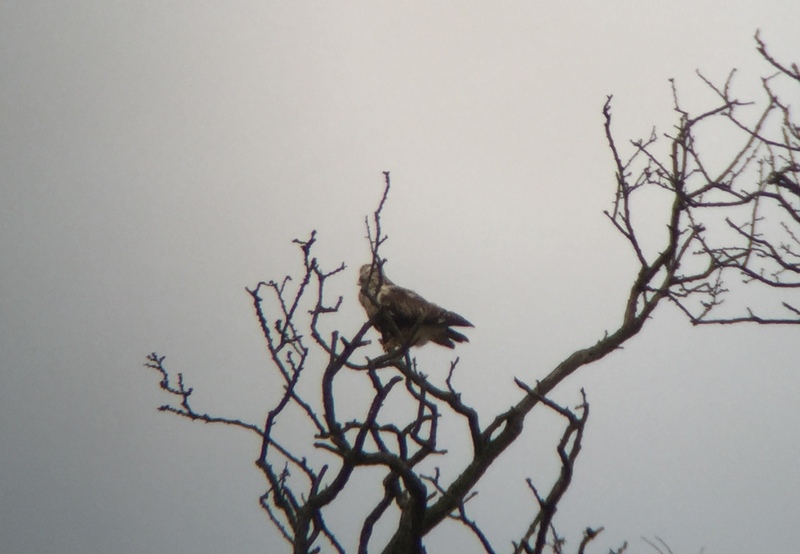 Rough-legged Buzzard – then one of the two in a tree
Rough-legged Buzzard – then one of the two in a tree
We watched the Rough-legged Buzzards for some time. One flew along the hedge and landed in another tree, then the second flew and forced it off its perch. The first then landed in a tree further along still and after a few moments the second came to join it. Finally the two of them drifted off back east towards the trees. It was an excellent way to start the day and great views.
Next, we stopped in an area of farmland where there are some nice overgrown weedy fields and unkempt hedges. Skylarks were singing and a Barn Owl was hunting out over the long grass. A tight flock of Linnets was whirling over the field and further along in the hedge we could see several Yellowhammers. A van came along the road and appeared to flush them all, but after they landed again we could hear a Corn Bunting singing distantly. As that was the bird we really wanted to see, we walked down along the road towards where they were.
They were hard to find at first. Lots of Yellowhammers came out of the hedges either side as we walked along, and dropped down into the weedy field beyond. When a farmer came along the road and drove into one of the fields, right by the hedge where most of the Yellowhammers had been, we thought that would be the end of it. But when we got further along, past where he was working, we could see all the birds gathered in the hedge on the other side of the field. Even better, perched in one of the small trees we could see five larger shapes. A quick look through the scope confirmed that they were Corn Buntings and we had a good look at them before they flew off.
 Brent Goose – a few hang around in Thornham Harbour
Brent Goose – a few hang around in Thornham Harbour
With our second target in the bag, we headed down to Thornham Harbour. The usual little gaggle of Brent Geese were hanging around at the end, but there was no sign of the Twite at first. We decided to walk out along the seawall to look further down towards Holme. When we had got half way along the bank, the flock of Twite flew over our heads and landed back in the harbour, from where we had just come. We decided to carry on and try for a better look on the way back.
As we walked out towards the dunes, we could hear Pink-footed Geese in the distance behind us. We turned to see lines upon lines of them heading our way, there must have been at least 3,000 of them. They gradually lost height and started whiffling down into the grazing marshes between us and Holme, landing on the grass – it was a fantastic sight and sound.
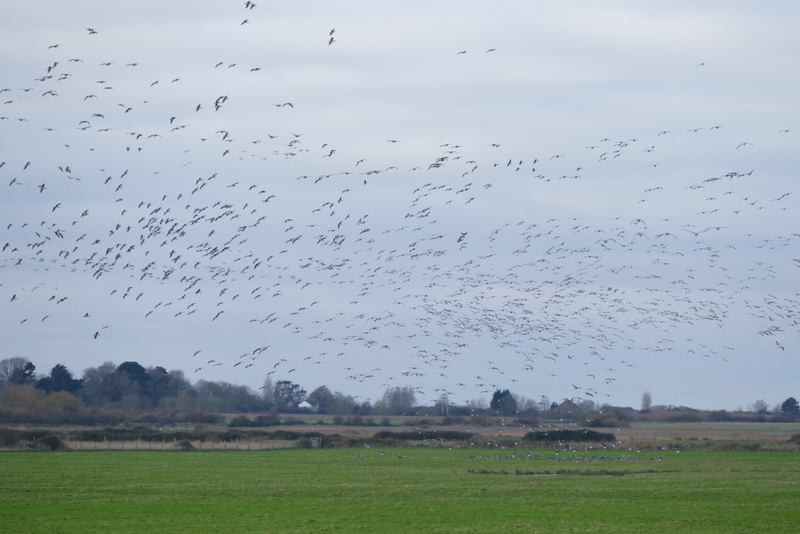 Pink-footed Geese – several thousand came into the fields at Holme
Pink-footed Geese – several thousand came into the fields at Holme
A little further along and a tight flock of small birds came hurtling in over the saltmarsh, over the bank and down towards Broad Water. They were Teal and just behind them we could see why – a Peregrine was after them. The ducks crashed down into the water and the Peregrine had to fly off empty-taloned.
The other bird we wanted to see here was Shore Lark. So we walked on out to the beach, stopping briefly to scan the sea from the dunes, before making our way round to the end of the dunes, which is the area they favour. We had only just got out of the dunes when the three Shore Larks flew up from the high tide line just ahead of us. They had obviously been tucked down amongst the piles of dead seaweed and other detritus, had probably crouched down as another group of people had walked ahead of us, then taken off when we approached.
We had hoped the Shore Larks would fly out to their favoured spot, but they turned and headed inland, disappearing behind the dunes. We carried on anyway, just in case they had doubled back but there was no sign of them and they didn’t return while we stood and scanned the beach. There were lots of waders out on the sand – Dunlin, Turnstone and Grey Plover, plus a group of roosting Bar-tailed Godwits around one of the damper pools.
We had also hoped we might find some interesting seaduck out here today, but it was windy this morning and there was quite a swell. Still, we walked back and along as far as the firs, scanning the sea. Most of the ducks were a long way out to sea. We could see a huge flock of Common Scoter, hundreds or even a thousand strong, which peeled up off the sea out in the middle, midway between us and the Lincolnshire coast, and circled round before landing again. There were a number Red-breasted Mergansers diving closer in and several Great Crested Grebes. A few Red-throated Divers flew east and a Fulmar went west, presumably heading for the cliffs at Hunstanton.
On our way back, the Twite were more obliging. We had just made it to the first bend in the seawall when they flew up from the saltmarsh below, a flock of around 30 of them. They flew off towards the harbour and looked like they might go down way over in the middle, but changed their minds and turned back. Eventually, they dropped back down where they had come from. This time we could get a good look at them in the scope, admiring their orange faces and breasts and yellow bills.
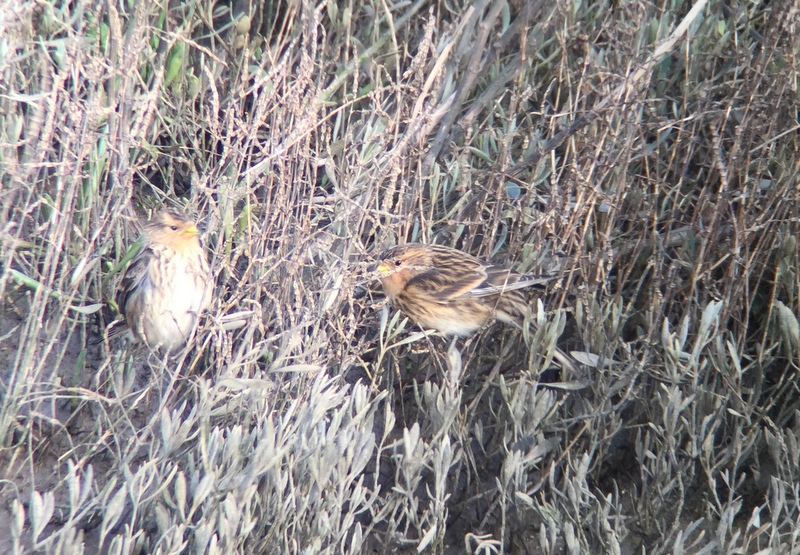 Twite – about 30 were around Thornham Harbour again
Twite – about 30 were around Thornham Harbour again
On our way back to the car, we stopped to admire a single Knot feeding in the mud, right beside the path. Then, as time was getting on, we headed round to Titchwell for lunch.
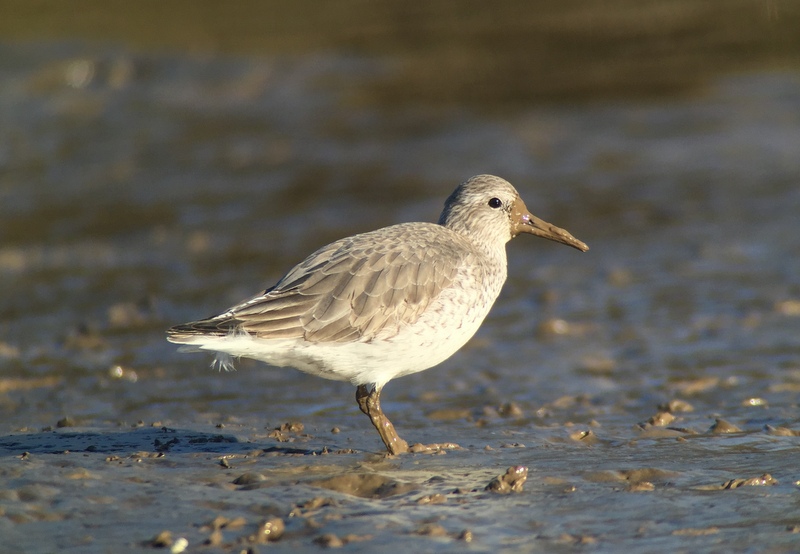 Knot – feeding in the mud at Thornham Harbour
Knot – feeding in the mud at Thornham Harbour
We really wanted to see if we could find some seaduck at Titchwell today, rather than explore the reserve, and we didn’t have much time available. Still, we tried to pick up many of the regular birds here as we went along. The feeders around the visitor centre were chock full of finches as usual, and it didn’t take long to find a smart male Brambling amongst them.
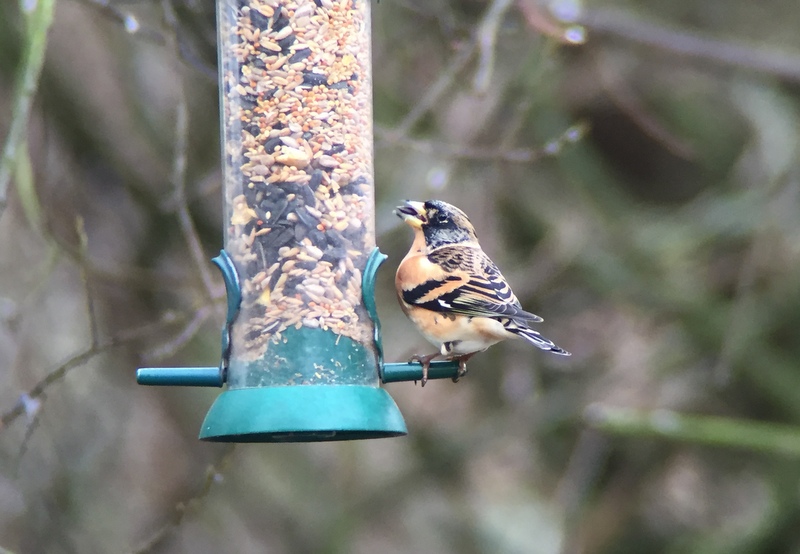 Brambling – a male on the feeders at Titchwell
Brambling – a male on the feeders at Titchwell
We stopped at the grazing meadow pool for a quick scan, but it looked rather quiet this afternoon. There were a couple of Rock Pipits but no sign of the Water Pipit with them. Other than a few Lapwing and a single Redshank, that was it out there today. A Kingfisher flashed over the reeds at the front and disappeared down into the channel on the saltmarsh.
The water level on the freshmarsh has gone well down now, and most of the birds were right out around the remaining water at the back. There were still a few Avocet and a small number of Black-tailed Godwit. A large flock of Dunlin did seem to be making the most of all the mud. A few Lapwing were feeding round the edges.
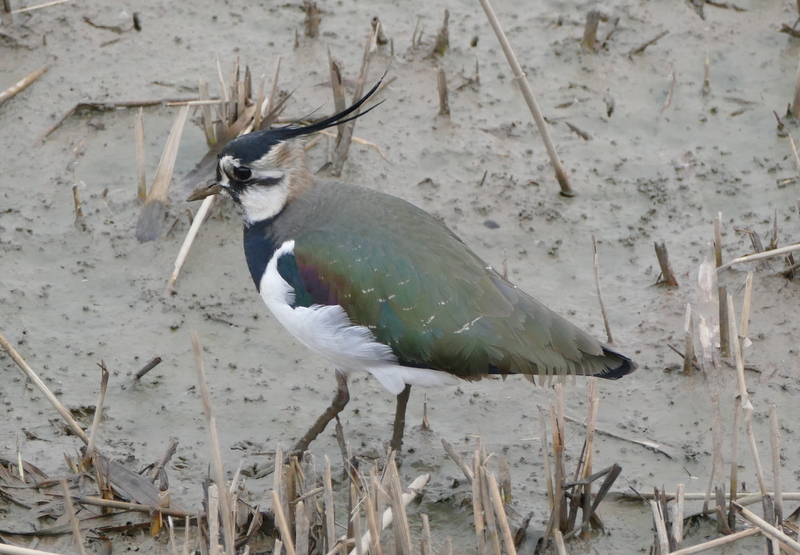 Lapwing – on the muddy edge of the freshmarsh
Lapwing – on the muddy edge of the freshmarsh
Duck numbers are now well down. There were still quite a few Teal, but nowhere near the number there has been, plus a small group of Mallard and a couple of Shoveler. We didn’t hang around here today, but moved quickly on to the Volunteer Marsh. There were all the usual waders on here – Curlew, Redshank and Grey Plover, plus a couple of Ringed Plovers as well.
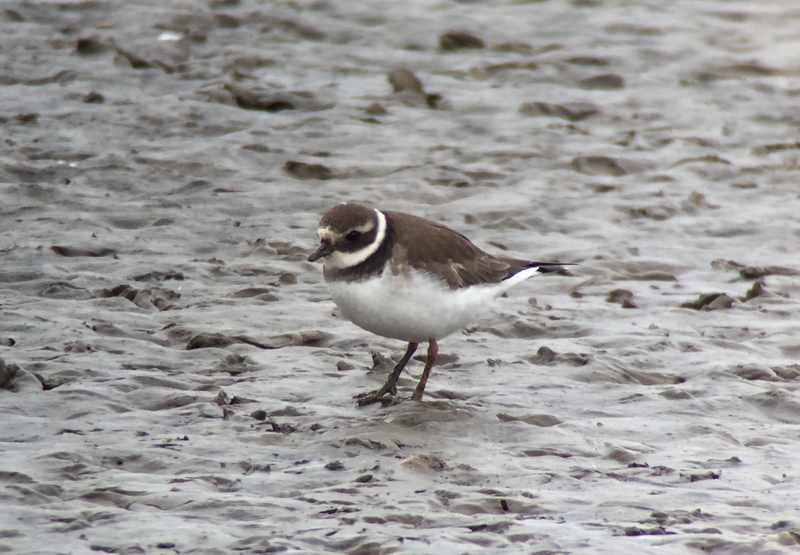 Ringed Plover – a couple were on the Volunteer Marsh
Ringed Plover – a couple were on the Volunteer Marsh
There was no sign of the Spotted Redshank on the Tidal Pools again today, but there were several Bar-tailed Godwit here. We did enjoy good views of three Goldeneye, including a smart drake. We also spent some time admiring the Pintail which were all on here today, all eleven of them.
 Goldeneye – this drake and two females were on the Tidal Pools
Goldeneye – this drake and two females were on the Tidal Pools
Our next stop was the beach and the tide was in, so there were not may waders out here today. We set ourselves to scan the sea. Once again it was very choppy, which didn’t make it easy. There were several Red-breasted Mergansers, but the flock of Common Scoter, while not as far offshore as the ones we had seen earlier, were still rather distant. We had hoped to see if there were any Velvet Scoter with them again today, but it was hard enough to see them in the waves and they were just that bit too distant.
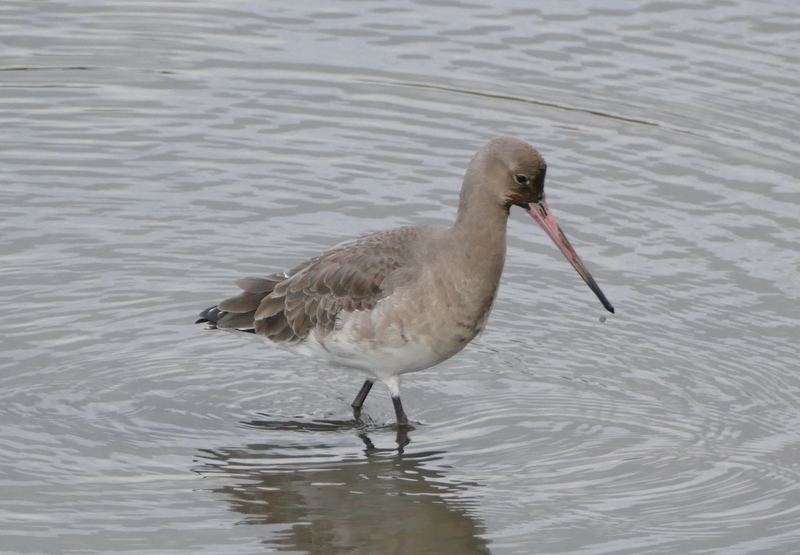 Black-tailed Godwit – by the path on the Tidal Pools
Black-tailed Godwit – by the path on the Tidal Pools
We made our way quickly back. A Black-tailed Godwit flew in and landed right by the path on the Tidal Pools. Back at the grazing meadow pool, there was no sign of any pipits now out on the mud, but a call behind us alerted us to one heading our way. It flew in high over the main reedbed, over the path and out towards Thornham over the mud, then turned and flew straight back to the reedbed before dropping down out in the middle of the reeds. When it came overhead, we could see it was very white underneath and relatively unstreaked – it was the Water Pipit, but it was not playing ball today.
Our final destination of the day was to be Roydon Common for the harrier roost, but we still had a little time to play with. It was a straight choice between going to see the Red-necked Grebe at Brancaster or go for another try looking at the sea at Holme. The choice was for the latter, so we drove back west along the coast road and set off across the golf course.
The sea didn’t look any more amenable here and the first couple of scans revealed nothing new – a few Great Crested Grebes and Red-breasted Mergansers. Out in the distance, a couple of auks whirred past. Then another scan revealed a pale duck out on the water which caught the afternoon sun. It was a Long-tailed Duck, but it was a long way out, drifting fast with the tide and diving. It was all but impossible to see and as soon as we found it, it was lost again. Unfortunately, we just couldn’t find it again to get everyone onto it. We had a date with some harriers and we had to tear ourselves away.
We arrived at Roydon Common in good time, and there was already quite a crowd assembled. The Pallid Harrier had arrived for the last couple of nights around 3.30pm. A Marsh Harrier was out over the heath, quartering back and forth. A ringtail Hen Harrier was already in when we arrived and eventually got up and did a fly round. The clock ticked on, and still there was no sign of the Pallid Harrier. It was a lovely evening, with clear skies as the sun dipped down behind us.
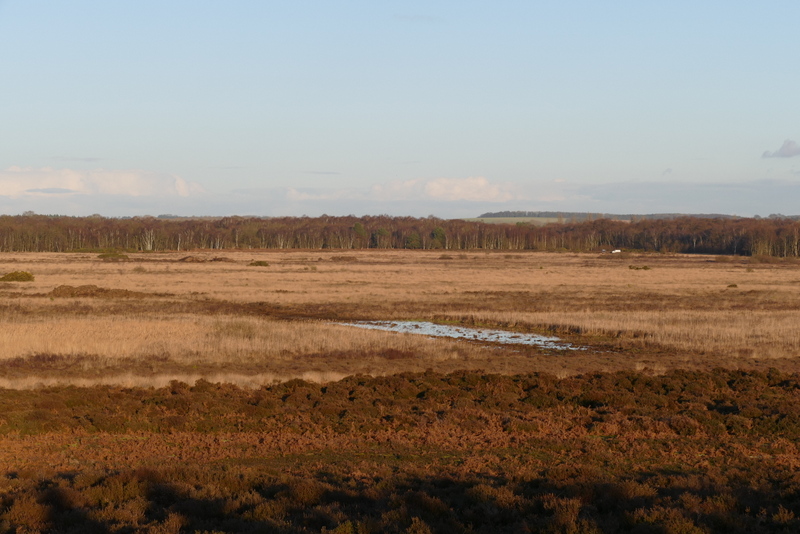 Roydon Common – it was a lovely evening out on the heath
Roydon Common – it was a lovely evening out on the heath
A second Hen Harrier flew in and dropped down into the grass. Still we waited. There were some nervous glances around the crowd now. The sun dipped below the horizon and a third and then a fourth Hen Harrier came in. By now, the light was just starting to fade a little and gradually the crowd started to leave. Eventually there were only about half a dozen of us left. However, harriers can come very late into roost, particularly on such a fine and calm evening, where they might choose to carry on hunting until the last moment. We were also still down on the usual count of Hen Harriers here, so we figured there must be more to come. We decided to stay.
It paid off. Suddenly the Pallid Harrier appeared – we could immediately see its comparatively small size and the dark patch or ‘boa’ really stood out on the side of its neck in the late evening light, and we could see the pale collar too. It circled round and the Hen Harriers started to get up for a last fly round as well. It was great to see the two species side by side – the Pallid Harrier smaller, slimmer with much more pointed wings and more buoyant flight.
Then even better, a Marsh Harrier appeared in the same view – the Pallid Harrier was the sandwich filling between the Marsh and a Hen Harrier! The Pallid and the Hen Harrier took it in turns to swoop down at the Marsh Harrier, before turning away in opposite directions.
It was a great way to end the day – a magical place, and well worth the wait!
















